Summer 2013: Young Voices
Light and Dark
Memoir by Colette Au
Caitlyn drew a worn-down stick of charcoal across the page, broadly laying down grainy strokes of her favorite color: black. Two long, charcoal-stained fingers scrubbed at a thick line, carefully smudging along a cheekbone. The oversized sheet of paper was draped over a metal easel she found in the basement, a convenient remnant of some forgotten childhood art project. Two other brown sheets of paper sat on her desk. Each held a portrait of my older sister’s face, but it would be blasphemous to call them similar, although they carried her style. Stark black markings developed shadows at her cheek and brow bones, dimness receding into her neck. Some lines ran together, an experiment with a moistened sponge. The other portrait was barely a gathering of lines, hinting at eye hollows and jawbones. Feet tucking neatly beneath me, I seated myself on the green quilted coverlet of Caitlyn’s bed.
Tilting my head slightly, concentrating on the sketch in progress, I searched for the emerging face. It had not yet arrived. That was the miraculous enigma of her work: one glance would yield a stark frenzy of charcoal strokes; the next, Caitlyn's likeness would materialize out of the paper highlights and charcoal shadows, the face of a spirit who encounters death and finds it raw but beautiful. It was expected all along, though, the light gravitating towards that haunting face. Staring at her own face, bound in a shiny gold frame, she raked it over in the full-length looking glass. Without taking her eyes from the mirror, she laid charcoal to page, guided by touch. Oblivious to the passing of time and the approach of midnight, she drew with a singular focus.
“Anything that I make is an abstraction. No matter how realistically I portray an object, portraying it in reality is impossible. I try to draw the essence of what I see, not what my mind thinks it is seeing.”
Caitlyn keeps her focus on the drawing, but carefully explains her artistic philosophy, her voice slow and muted in concentration. She sighs, exasperated at my look of bemusement; tries again, grasping for ways to convey this crucial information.
“Take drawing a self-portrait, for example. Most people would draw an oval first, but a real face is actually defined in relative shades of light and dark.”
I nod slowly, carefully parsing through her words and filing the knowledge away. She puffs out her cheeks again, breaking the silence in a sigh: “Oh, your brain must be too logical, too analytically-inclined, for weird artsy stuff.”
I understand most of the concept in an abstract way, shrugging.
Logically, a mind names a face a face when it receives a specific pattern of color information from the eyes. If one draws the core elements of what the eye sees, the mind will recognize the image, even if it is not hyper-realistic. That is the key to Caitlyn’s art. After months of drawing studio sessions with live models, she can extract the feel of a person’s face. It is unexplainable, this latent talent that only just emerged. For sixteen years of life, she spent her time practicing piano, memorizing trigonometric identities, and playing tennis. It was unthinkable to pursue anything else, not in our household. She never felt truly happy; I was never unhappy.
Now, she is the ultimate conventionally-raised rebel: the best in her class, but while studying glass at an internationally recognized art school. She spends a full ninety hours a week between history lectures, occasional six-hour long studio sessions, and the glassblowing shop. When Caitlyn is sculpting, drawing, painting, critiquing, she is weightless, unbound from the trivial constraint of time and the confines of standard intelligence. For all the analytical skills bestowed upon me, creative talent raises a question that has no convenient, molded answer and explanation. I fear for my impatient self. Do I even possess exceptional talent, waiting to suddenly reveal itself? I excel at allowing myself leeway for my passions, but shortly after, binding those unnecessary thoughts away.
Lost in reflection, I miss its arrival for the third time. Wordlessly tracing the angular strokes of her eyes with my own, I exhale. Over an hour has passed since she had slid an empty, brown paper sheet onto her easel. She turns around to face me, seeming to wonder how I appeared on her bed.
| |

|

|
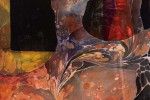 |
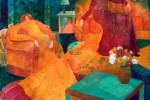 |
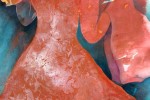 |
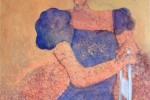 |
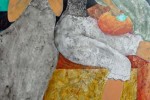 |
||||
|
Rich, strong, poignant, humorous and inspiring. We’ve caught twenty never-before-published poems by sixteen unique voices. |
Seven talented women search for themselves in their bodies, their family, themselves. |
Established dynamos and aspiring voices add colorful visions to our third issue. |
Language leaps off the page in the poetry and prose of five young authors who delight in sensory detail. |
Meet the authors and artists who make this Summer 2013 edition a rich, varied and engaging experience. |

|
LETTER FROM THE EDITORS
POETRY Abandoned Church by Tanya Jarvik Commencement by Kelly Running Depoe Bay by Wendy Thompson Directive by Cristina White Hawk Moth by Wendy Thompson How to Recycle Love Letters by Jennifer Dorner I Swapped a '74 Mustang for This by Jennifer Fulford Polaroid of My Mother by Cindy Stewart-Rinier Lover, Molester, and Maindens (Haibun) by Margaret Chula Savory by Pat Phillips West Seascape by Marjorie Power Suspended by Grace Kuhns The Hand-Off by Pattie Palmer-Baker The Ride by Linda Ferguson The Ticking Shirt by Tricia Knoll Three Facts about Sperm by Ursula Whitcher Three True Stories by Penelope Scambly Schott Today at the Library by Pat Phillips West Trapped Birds by Grace Kuhns You, who will be alive and reading after I'm gone by Penelope Scambly Schott PROSE After the World Ends by Kait Heacock Something Permanent by Ashley-Renée Cribbins Your Hand at Your Throat by Karen Guth Black Sharpie by Anne Gudger Diagnosis by Helen Sinoradzki For He's a Jolly Good Fellow by Laura Stanfill Breathing Underwater by Valerie Wagner ART Unity by Anne John Rearguard by Anne John Speculation by Anne John Wire by Jocelyn White Taitian Trio by Nani Chesire Catch Your Breath by Nani Chesire YOUNG VOICES We Will Read to You by Rebecca Cleveland-Stout Strawberry Party by Natalie Lerner A Young Night by Clara Beaumont Beach Wanderer by Isabella Waldron Light and Dark by Colette Au CONTRIBUTORS |
